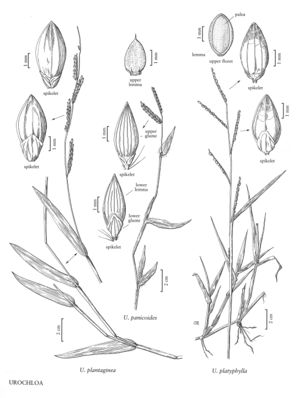Urochloa panicoides
Plants annual. Culms (5)10-55(100) cm, erect to decumbent, usually rooting at the lower nodes; nodes pubescent; internodes glabrous or sparsely pubescent. Sheaths hispid, margins ciliate distally; ligules 1-1.5 mm; blades (2)5-25 cm long, 5-18 mm wide, both surfaces usually with papillose-based hairs, rarely glabrous, bases rounded to subcordate, ciliate, with papillose-based hairs. Panicles 3.5-10 cm long, 2-7 (10) cm wide, with 2-7(10) spikelike primary branches in 2 ranks; primary branches 1-7 cm, axes about 0.9-1.2 mm wide, flat, scabrous and ciliate with papillose-based hairs; secondary branches rarely present; pedicels shorter than the spikelets, frequently with 1-5 long hairs. Spikelets 2.5-4.5(5.5) mm long, about 1.5-2 mm wide, ellipsoid, solitary, in 2 rows, appressed to the branches. Glumes scarcely separated; lower glumes 1-1.6 mm, 1/4-1/3(1/2)as long as the spikelets, 3-5-veined, clasping the base of the spikelets, glabrous; upper glumes 3.2-4.3 (5) mm, 9-11(13)-veined, glabrous; lower florets sterile; lower lemmas 3.2-4.3 (5) mm long, glabrous, 5(-7)-veined; lower paleas present; upper lemmas 2.6-3.5 mm long, about 1.5 mm wide, apices rounded, awned, awns (0.3)0.6-1 mm; anthers 0.8-1 mm. Caryopses 2-2.5 mm. 2n = 30, 36, 48.
Distribution
Md., Ariz., N.Mex., Tex.
Discussion
Urochloa panicoides is native to Africa, and is considered a noxious weed by the U.S. Department of Agriculture. In the Western Hemisphere, it has been introduced into the southern United States, Mexico, and Argentina. Within the Flora region, it has been reported from disturbed sites in the southern and Gulf Coast areas of Texas (Wipff et al. 1993), but it is expected to spread. Populations from New Mexico have been destroyed.
Urochloa panicoides has morphological forms with glabrous, pubescent, or setosely-fringed spikelets. Although the three forms have been recognized taxonomically, Clayton and Renvoize (1982) state that they appear to be of no taxonomic significance. Only the glabrous form is known to occur in the Flora area.
Selected References
None.
